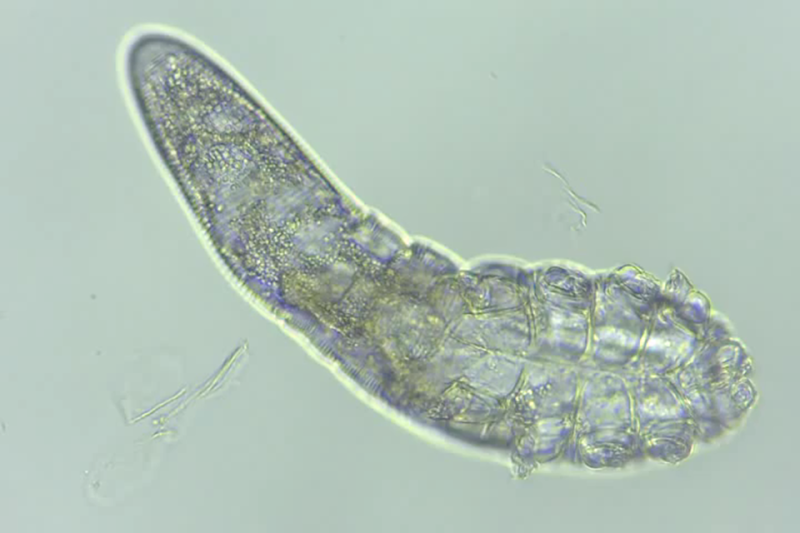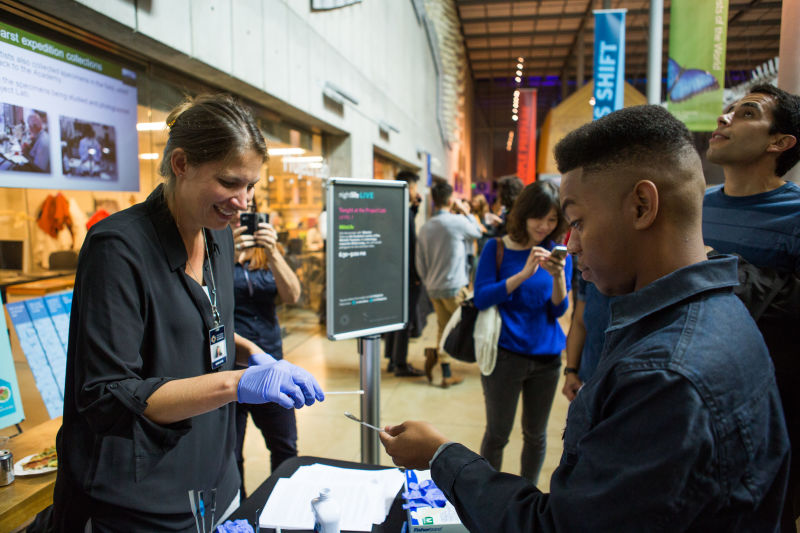Listen to the Story:
We Need to Talk About Your Face. It's Got Mites.

We Need to Talk About Your Face. It's Got Mites.
We need to talk about something. You might want to sit down. Microscopic animals have colonized your face. No, really. Inside your pores, right in there among the dirt and oil, face mites have set up shop and they’re not going anywhere.
Before you shudder in horror and reach for facial scrub, pause to consider these remarkable creatures. We’ve all got them, and in all likelihood they have been our species’ steadfast companions since time immemorial.
“We’ve probably had them forever, even since before we were human,” says Michelle Trautwein, a curator at the California Academy of Sciences who studies the evolutionary history of these tiny arachnids. (Yep, they’re related to spiders, but don’t hold that against them.)

Recently, at one of the CalAcademy’s after-hours parties, Trautwein recruited participants for her latest study. One of her more intriguing recent findings has been that face mite evolution is intimately linked to human evolution — our family trees seem to mirror each other.
“All humans originated in Africa,” she says, “and because of that Africa hosts most human genetic diversity, and it turns out they also host the most mite diversity.”
Trautwein has also found evidence for more diverse lineages of mites among East Asian and Latin populations. So when Rafael Vega, visiting from Mexico City, walks by her table at the CalAcademy, she and graduate student Misha Leong are eager to sample his mites.
Leong applies mineral oil around the base of his nose.
“It’s right in these crevices where we’ve found a lot of the face mites seem to congregate,” she explains.
She hands Vega a thin metal scraper and demonstrates the downward sweeping motions he can use to scrape his skin.
“Because we’re trying to get as much oil and dead skin cells as possible,” Leong says, “so that we can hopefully extract some face mite DNA.”
This is the first time Vega has ever heard about his face mites, but he’s taking the news in stride.
“It’s nice to know they’re there,” he says. “They’re treating me well, as far as I know. I hope they’re behaving all right.”
They probably are. Occasionally face mites are linked with skin ailments like rosacea (and in animals, mites are thought to cause mange) but generally the tiny, 8-legged creatures are harmless. (Although Demodex folliculorum sure has an “Ewww!” factor in this video by Daniel Fergus, of the North Carolina Museum of Natural Sciences and North Carolina State University.)
Since it’s difficult to collect the mites and spot them under a microscope, scientists used to think that only 10 to 25 percent of people had them. But by detecting face mites through their DNA, Trautwein’s research has shown all humans host the creatures, likely inherited from our family members shortly after we are born.
Mites also seem to travel with us through generations. One thing Trautwein is trying to figure out is why African Americans who have been gone from Africa for decades can still host African face mites.
“I want a much broader sample so I can really start to tease out what that’s about,” she says. “How much African ancestry do you have to be able to host an African mite?”
She’s also curious about how many kinds of mites we really host. At the moment it’s clear at least two species live on our faces. Examined through a microscope, they appear morphologically different. But it’s possible, she thinks, that further research will reveal many more kinds of mites.

“What’s crazy is that we actually have mites all over our body,” she says. “We have mites that live in our ears, that live on our face, that live on our eyebrows, versus our eyelashes, versus our genitals, versus our nipples.”
In other words, they are all over the place, and she wouldn’t be surprised if there are many different species.
Trautwein hopes she will get to investigate these questions, but securing funding to scrape face mite exoskeletons from people hasn’t always been easy. Some of the National Science Foundation reviews of her grant applications have been unenthusiastic, she says, suggesting that she’s going to make people paranoid and neurotic.
But Trautwein says that’s not the reaction she gets.
“What I’ve found is that people think they’re gross,” she says, “but they still love it and they want to find out and they want to get sampled.”
Trautwein hopes to publish her newest research on the diversity of human face mites sometime next year.

